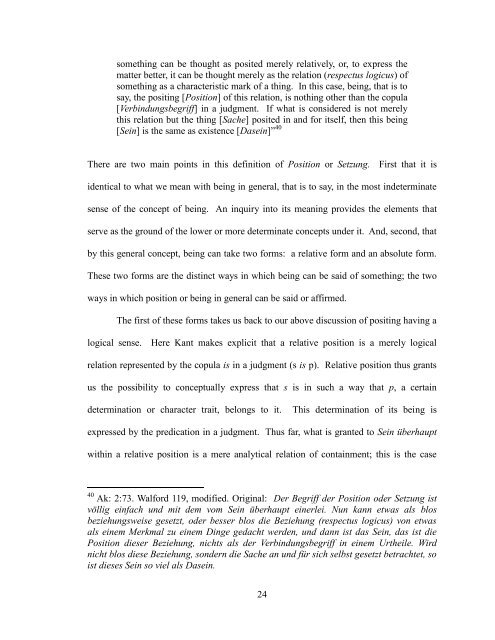The Doctrine of Self-positing and Receptivity in Kant's Late ...
The Doctrine of Self-positing and Receptivity in Kant's Late ...
The Doctrine of Self-positing and Receptivity in Kant's Late ...
You also want an ePaper? Increase the reach of your titles
YUMPU automatically turns print PDFs into web optimized ePapers that Google loves.
someth<strong>in</strong>g can be thought as posited merely relatively, or, to express the<br />
matter better, it can be thought merely as the relation (respectus logicus) <strong>of</strong><br />
someth<strong>in</strong>g as a characteristic mark <strong>of</strong> a th<strong>in</strong>g. In this case, be<strong>in</strong>g, that is to<br />
say, the <strong>posit<strong>in</strong>g</strong> [Position] <strong>of</strong> this relation, is noth<strong>in</strong>g other than the copula<br />
[Verb<strong>in</strong>dungsbegriff] <strong>in</strong> a judgment. If what is considered is not merely<br />
this relation but the th<strong>in</strong>g [Sache] posited <strong>in</strong> <strong>and</strong> for itself, then this be<strong>in</strong>g<br />
[Se<strong>in</strong>] is the same as existence [Dase<strong>in</strong>]‖ 40<br />
<strong>The</strong>re are two ma<strong>in</strong> po<strong>in</strong>ts <strong>in</strong> this def<strong>in</strong>ition <strong>of</strong> Position or Setzung. First that it is<br />
identical to what we mean with be<strong>in</strong>g <strong>in</strong> general, that is to say, <strong>in</strong> the most <strong>in</strong>determ<strong>in</strong>ate<br />
sense <strong>of</strong> the concept <strong>of</strong> be<strong>in</strong>g. An <strong>in</strong>quiry <strong>in</strong>to its mean<strong>in</strong>g provides the elements that<br />
serve as the ground <strong>of</strong> the lower or more determ<strong>in</strong>ate concepts under it. And, second, that<br />
by this general concept, be<strong>in</strong>g can take two forms: a relative form <strong>and</strong> an absolute form.<br />
<strong>The</strong>se two forms are the dist<strong>in</strong>ct ways <strong>in</strong> which be<strong>in</strong>g can be said <strong>of</strong> someth<strong>in</strong>g; the two<br />
ways <strong>in</strong> which position or be<strong>in</strong>g <strong>in</strong> general can be said or affirmed.<br />
<strong>The</strong> first <strong>of</strong> these forms takes us back to our above discussion <strong>of</strong> <strong>posit<strong>in</strong>g</strong> hav<strong>in</strong>g a<br />
logical sense. Here Kant makes explicit that a relative position is a merely logical<br />
relation represented by the copula is <strong>in</strong> a judgment (s is p). Relative position thus grants<br />
us the possibility to conceptually express that s is <strong>in</strong> such a way that p, a certa<strong>in</strong><br />
determ<strong>in</strong>ation or character trait, belongs to it. This determ<strong>in</strong>ation <strong>of</strong> its be<strong>in</strong>g is<br />
expressed by the predication <strong>in</strong> a judgment. Thus far, what is granted to Se<strong>in</strong> überhaupt<br />
with<strong>in</strong> a relative position is a mere analytical relation <strong>of</strong> conta<strong>in</strong>ment; this is the case<br />
40 Ak: 2:73. Walford 119, modified. Orig<strong>in</strong>al: Der Begriff der Position oder Setzung ist<br />
völlig e<strong>in</strong>fach und mit dem vom Se<strong>in</strong> überhaupt e<strong>in</strong>erlei. Nun kann etwas als blos<br />
beziehungsweise gesetzt, oder besser blos die Beziehung (respectus logicus) von etwas<br />
als e<strong>in</strong>em Merkmal zu e<strong>in</strong>em D<strong>in</strong>ge gedacht werden, und dann ist das Se<strong>in</strong>, das ist die<br />
Position dieser Beziehung, nichts als der Verb<strong>in</strong>dungsbegriff <strong>in</strong> e<strong>in</strong>em Urtheile. Wird<br />
nicht blos diese Beziehung, sondern die Sache an und für sich selbst gesetzt betrachtet, so<br />
ist dieses Se<strong>in</strong> so viel als Dase<strong>in</strong>.<br />
24


